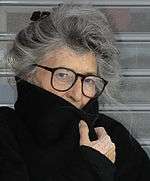Myra Landau

Myra Landau (born December 5, 1926) is an artist and abstract painter involved in art research. Born in Bucharest, Romania, she is known largely for the work she made in Brazil, then Mexico for many years and later in Italy, Israel and The Netherlands.
History
Myra Landau was born December 5, 1926 in Bucharest, Romania. After extensive travel throughout Europe during the Second World War, she arrived in Brazil with her family. Her great interest in artistic and intellectual life gave her the opportunity to meet painters like Di Cavalcanti, Antonio Dias, Wesley Duke Lee, Francisco Brennand, Antonio Dias and João Camara, the sculptor Sergio Camargo, the writer Jorge Amado and poet-musician-diplomat Vinicius de Morais, the musician-painter Dorival Caymmi.
Shy but determined, she started to paint. Her first works were figurative but gradually she began to realize that this was not her style. Influenced by Dufy, she painted her way out of figurative art and entered into Expressionism. A very decisive moment in her life was when her uncle Marcel Janco (one of the founders of Dadaism) came to visit her family and was very impressed by her work. Another important artist in her career was the great Brazilian engraver Oswaldo Goeldi. Critics, like Mario Pedrosa, Aracy Amaral, Frederico de Morais (Brazil), Jorge A. Manrique (who described her work as being "brutal and refined’)[1] and Rita Eder have recognized Myra Landau's artistic contribution, describing it with high esteem.
Landau has lived in six countries, whose diverse cultures gave her work a cosmopolitan outlook. She married Miguel Salas Anzures, head of Fine Arts-INBA, Mexico. He broke with Socialist Realism, represented by painters like Diego Rivera, José Clemente Orozco, David Alfaro Siqueiros. This new expression of art was called Generación de la Ruptura. The members of this generation of artists include native-born Mexicans and immigrants, many of which were refugees from World War II. Along with José Luis Cuevas, these include Fernando García Ponce, Roger Von Gunten, Edmundo Aquino, Francisco Toledo, Arturo Rivera, Leonora Carrington, Alberto Gironella, Ricardo Martínez, Arnaldo Coen, Lilia Carrillo, Vlady, Manuel Felguérez, Gilberto Aceves Navarro, Gustavo Arias Murueta, Luis López Loza, Luis Almeida, Peggy Espinosa, Adolfo Falcón, Efraín Herrero, Rafael López Castro, Bernardo Recamier, Pablo Rulfo and Vicente Rojo.
Myra introduced a new technique of engraving on metal, utilizing acids, but printed from the surface, called Metal Relief. She had her first exhibition in Mexico in 1963 and gradually became one of the leading Latin American women artists.[2] Her Metal Relief works were well received by art critic Paul Westheim in the important magazine El Nuevo Arte de los Metales and by art connoisseur, reviewer and historian Jorge Olvera. She continued her in-depth research and found her definitive expression in painting with pastel on raw linen. In this technique she was a pioneer. Her thematic approach was also new: she was the first Latin American abstract painter to use movements of free geometrical lines. All her works since 1965 are called Rhythms.
In 1974 she began working as a teacher in the University of Veracruz in the faculty of Fine Arts. In 1975 she became a full-time researcher for the Institute of Aesthetics and Artistic Creation at the University.
Myra Landau had more than sixty individual exhibitions, the most important of which was held in 1987 in the Museum of Modern Art in Mexico City. She participated in 150 group exhibitions in Mexico, France, Italy, Brazil, Chile, United States and Cuba.
In 1994, she moved from Mexico to Rome, Italy, and later to Jerusalem, Israel where she lived for 6 years. Myra Landau currently resides in Holland.
References
Sources
- Galeria Ferrari - Mexico
- https://www.annexgalleries.com/artists/biography/4193/Landau/Myra}
- http://www.pinacoteca.org.br/pinacoteca-pt/default.aspx?mn=545&c=acervo&letra=M&cd=3108]
- https://searchworks.stanford.edu/view/4049792]
- http://www.uv.mx/universo/412/arte/arte_03.html]
- http://www.museodeartecarrillogil.com/exposiciones/exposiciones-anteriores/myra-landau]
- https://issuu.com/mssachile/docs/catalogo_mexico_full]
- http://www.elclarin.cl/web/noticias/cultura/20467-el-mssa-inaugura-a-los-artistas-del-mundo-muestra-realizada-en-conjunto-con-el-muac-de-mexico.html]
- http://www.instituteofmexicodc.org/images/GM_catalog_web.pdf]
- http://www.latinamericanart.com/es/artistas/myra-landau/biografia.html
- http://patrimonioygenero.dibam.cl/651/articles-49720_archivo_01.pdf
- http://cdigital.uv.mx/bitstream/123456789/4124/2/197618P96.pdf
- http://www.proceso.com.mx/129050/esta-presencia-de-mexico-en-cuba
- https://issuu.com/la_sonrisa/docs/zo19_web
- http://www.casalamm.com.mx/tesis/doctorado_en_historia_del_arte/sagrario_iliana_martinez_juarez.pdf
- http://discursovisual.net/1aepoca/dvweb08/art01/art01.html
- http://www.artesehistoria.mx/sitio-contenido.php?id_sit=99&id_doc=1421
- http://www.milenio.com/cultura/Exposion_en_Museo_de_Arte_Moderno-50_aniversario_del_Museo_de_Arte_Moderno-muestras_del_MAM-exposicion_La_coleccion-muestra_Estio-muestra_Estudio_de_Trazo_0_307169564.html
- http://www.mauc.ufc.br/expo/2000/02/obras1.htm#Myra_Landau
- http://www.evandrocarneiroleiloes.com/145675?artistId=123454